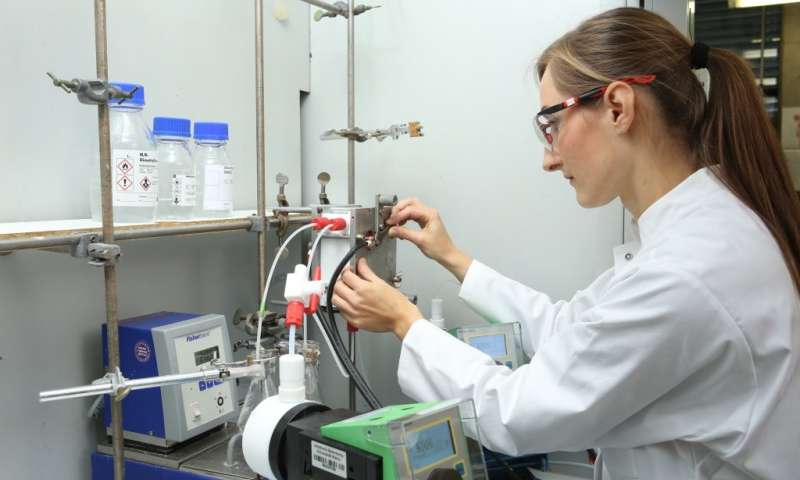
Innovative contribution to the energy transition
In the cooperative EPSYLON research project funded by the German Federal Ministry of Education and Research, scientists from Johannes Gutenberg University Mainz (JGU) and Evonik Performance Materials GmbH have succeeded in developing a state-of-the-art and innovative electro-organic synthesis. The results of their research, presented in last week’s issue of Science Advances, allow the use of electrosynthesis as a trend-setting and sustainable green chemistry for technical applications. The method developed allows the operator to react flexibly to the available supply of electricity. Moreover, the operator no longer has to rely on customized electrolysis apparatuses and can use a wide variety of different equipment.
The method of carrying out chemical reactions using electricity was developed more than 160 years ago by German chemist Hermann Kolbe. Although electrochemical syntheses are used in the chemical industry, this has so far been a niche technology. One reason is that the electrolysis conditions must be very finely controlled and uniform current input is essential. Due to the sophisticated technical infrastructure, the option of electrosynthesis remained unknown to most chemists. Now, in the 21st century, the green potential of electrochemistry has been rediscovered. It makes sustainable and eco-friendly chemistry possible with very simple means, particularly with the use of surplus power from renewable sources, such as wind or solar energy.
Electrochemistry is a versatile and powerful method that can be used to produce various chemical compounds or to effect chemical changes in molecules. To put it simply, electrons replace costly and toxic reagents. Unnecessary wastes can be avoided and the reaction can be halted at any time by simply switching off the power. Another advantage over classical synthesis is that many individual steps are more easily implemented by electrochemistry. In some cases, this can shorten a synthesis by several steps. However, electrolyses often require a narrow current-density window and long reaction times. In addition, selectivity and scalability are more difficult or even impossible.
The key to the success of the research group headed by Professor Siegfried Waldvogel of the Institute of Organic Chemistry at Johannes Gutenberg University Mainz is the use of a unique electrolyte system. The electrolyses here have extremely high stability to variation in current density, allowing operation in a current-density window with a width extending over more than two orders of magnitude, with no loss of productivity or selectivity. If the supply of current permits, the electrolysis may be carried out in a short time with very high current density.
Learn more: New electro-organic synthesis allows sustainable and green production of fine chemicals
The Latest on: Electro-organic synthesis
[google_news title=”” keyword=”electro-organic synthesis” num_posts=”10″ blurb_length=”0″ show_thumb=”left”]- Best Organic Mattress for 2024on April 30, 2024 at 8:00 pm
If you’re looking for a mattress that’s supportive, comfortable and environmentally friendly, then an organic option might be ideal for you. There are a lot of reasons to choose an organic ...
- Researchers achieve electrosynthesis via superwetting organic-solid-water interfaceson April 29, 2024 at 7:11 am
Chinese scientists have recently achieved the direct synthesis of high-purity benzaldehyde chemicals from the selective electrooxidation of benzyl alcohol. The organic-solid-water (OSW) three-phase ...
- Electrochemistry Paves the Way: Sustainable Synthesis Method Reveals N-Hydroxy Modifications for Pharmaceuticalson April 16, 2024 at 8:25 am
New highly selective and scalable electro-organic synthesis of novel benzo[e]-1,2,4-thiadiazine-1,1-dioxides which represent an important structural motif of APIs (active pharmaceutical ...
- Sustainable synthesis method reveals N-hydroxy modifications for pharmaceuticalson April 16, 2024 at 7:51 am
Electrochemistry plays a decisive role in this development as electro-organic synthesis is a method that avoids large amounts of waste generated by conventional chemical transformations.
- Organic Chemistryon January 18, 2024 at 11:10 am
Organic chemistry is the study of the structure, properties, composition, reactions, and preparation of carbon-containing compounds. Most organic compounds contain carbon and hydrogen, but they may ...
- About the Editorson March 15, 2021 at 10:57 pm
Peter obtained his MSci degree in Chemistry from University College London in 2016, before carrying out a PhD in the interdisciplinary topic of electro-organic synthesis at the same institution.
- Name Reactions in Organic Synthesison September 16, 2016 at 4:43 am
2016. Synthesis of 3‐Substituted 2‐Indolinones by a Multicomponent Coupling Isocyanide‐Dependent Microwave‐Assisted Intramolecular Transamidation Process. European Journal of Organic Chemistry, Vol.
- Protein Synthesison May 19, 2016 at 7:50 am
So how does protein synthesis make hair? If you've looked at the activity (or even the text version of the activity), you know how a section of DNA instructs a cell how to make a protein.
via Google News and Bing News










